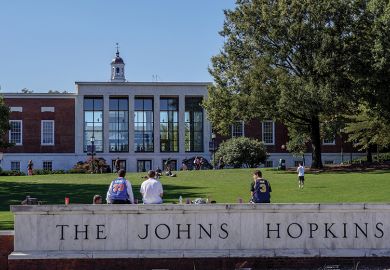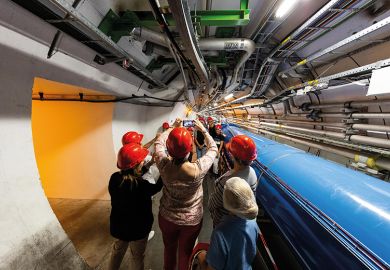Browse the full results of the World University Rankings 2025
Winning research grants is increasingly hard in today’s ever more competitive academic world.
Johns Hopkins University is the longstanding leader in the US on this measure, securing a record $3.4 billion (£2.7 billion) in federal funds for research and development in 2022, but it does not simply rely on its great reputation to win grants. Denis Wirtz, who has been vice-provost for research at the institution for 10 years, says strategically determining the right amounts of money for internal research awards and supporting academics in writing large grant proposals are among the factors for its success.
“We’ve gone from a competitive to a hypercompetitive environment,” Wirtz says. “We think that the old model of providing basic funds and physical infrastructure to get [researchers] started…basically ended some time ago.”
One of Johns Hopkins’ internal funding programmes is the catalyst awards, aimed at early career researchers; only those who have spent less than 10 years on the tenure track are eligible. About 150 faculty apply each year to win a grant, worth up to $75,000, and about 12 to 15 per cent are successful.
When early career faculty are promoted to associate professor, they are expected to embark on a big second line of research, Wirtz explains, but this is tough to do without funding, and obtaining that initial research grant is notoriously hard.
As such researchers are also “primed for poaching” by rival institutions, Wirtz continues, the award has the secondary aim of ensuring that faculty feel supported and stay put.
Johns Hopkins also operates a discovery awards scheme. These are grants of $100,000 specifically for interdisciplinary projects. Acting as a stepping stone to the big federal grants of $5 million-plus, they enable researchers to pull together a team, prove they can work together and obtain some preliminary data.
The awards criteria include having a team that features people from at least two departments, and, of course, submitting a proposal. The bid needs to be only three pages or so in length, to limit the time and paperwork involved.
Finding the “sweet spot” for the size of this award is crucial, according to Wirtz. “It’s small enough that people don’t think this is a substitute for a federal grant or private foundation grant, but large enough that you can do something with it,” he says. “If you give faculty a million dollars, they’ll stop writing grants!”
Wirtz believes other institutions err when they dictate which types of projects they will fund in this way. “They say, ‘This year, we’re going to support collaborative internal grants in energy, or in climate change.’ We say the best ideas will come from the community.”
As an active researcher himself, Wirtz is aware of the burden on scientists when it comes to drafting proposals for external grants; most proposals consist of “20 or 15 pages of actual science, but then hundreds of pages of crap. Quote me on that.”
To help lift the load, he established the research development team: an office with about five staff who act like a “SWAT team” to support academics pursuing large grant proposals. The team includes finance and administrative staff, as well as science writers who can pull together the narrative – which is especially useful for an interdisciplinary proposal that has input from several people with different specialisms and terminology.
Wirtz believes this type of office is unique. “I don’t understand why no one else has done this. But I won’t complain because it makes us more competitive.”
Having pitched the idea some five years ago as an experiment, he admits that it was first met with “healthy scepticism”. People said of it, “here is another office created centrally [and] more administrators”, he recalls. But “fast-forward, and no one talks like that. There are very happy customers across the university.”
Now, instead of devoting a year and half to a large grant proposal, academics can spend a month and a half, which allows for “more shots on goal”, Wirtz says. If they don’t win a grant, they’re less dejected, so they go for another one and get it the second time around, he adds.
“Time is the most precious commodity, and I’m perpetually thinking of ways in which I can eliminate silly, busy, stupid work,” he explains.
It’s one thing setting up grants for faculty, but another encouraging them to apply. Wirtz’s job also involves constant promotion of the internal funding opportunities, and he has some unusual methods. Speed dating events to encourage faculty from different disciplines to meet is one. Another is tinkering with email subject lines.
“I try to trick faculty into opening the emails,” he says. “I joke that if I were to put ‘Free money just for you’, they still wouldn’t open it.”
Register to continue
Why register?
- Registration is free and only takes a moment
- Once registered, you can read 3 articles a month
- Sign up for our newsletter
Subscribe
Or subscribe for unlimited access to:
- Unlimited access to news, views, insights & reviews
- Digital editions
- Digital access to THE’s university and college rankings analysis
Already registered or a current subscriber?








